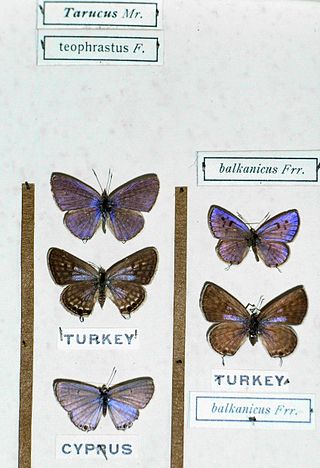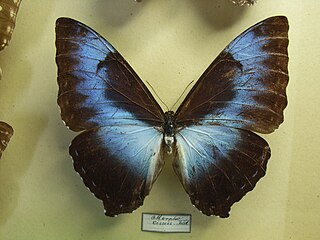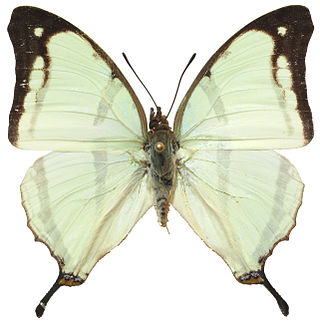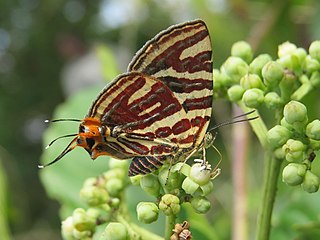
The black hairstreak is a butterfly in the family Lycaenidae.

Papilio clytia, the common mime, is a swallowtail butterfly found in south and southeast Asia. The butterfly belongs to the subgenus Chilasa, the black-bodied swallowtails. It serves as an excellent example of a Batesian mimic among the Indian butterflies.

Tarucus theophrastus, the common tiger blue, pointed Pierrot or African Pierrot, is a small butterfly found in the Old World tropics. It belongs to the lycaenids or blues family.

Apatura ilia, the lesser purple emperor, is a species of butterfly native to most of Europe and east across the Palearctic. It is named for its similarity to the purple emperor butterfly.

The Indian fritillary is a species of butterfly of the nymphalid or brush-footed family. It is usually found from south and southeast Asia to Australia.

Parnassius clodius is a white butterfly which is found in the United States and Canada. It is a member of the snow Apollo genus (Parnassius) of the swallowtail family (Papilionidae). Its elevation range is 0–7,000 ft (0–2,134 m).

Deudorix epijarbas, the cornelian or hairy line blue, is a species of lycaenid or blue butterfly found in south and southeast Asia from India to Fiji, including the Philippines, and also the tropical coast of Queensland in Australia. The species was first described by Frederic Moore in 1857.

Rapala varuna, the indigo flash, is a species of lycaenid or blue butterfly found in the Indomalayan realm and the Australasian realm.

Hippotion celerio, the vine hawk-moth or silver-striped hawk-moth, is a moth of the family Sphingidae. It was described by Carl Linnaeus in his 1758 10th edition of Systema Naturae.

Morpho deidamia, the Deidamia morpho, is a Neotropical butterfly. It is found in Panama, Nicaragua, Costa Rica, Suriname, Bolivia, Venezuela, Colombia, Peru, Ecuador, and Brazil. It is a species group, which may be, or may not be several species. Many subspecies have been described.

Melitaea didyma, the spotted fritillary or red-band fritillary, is a Palearctic butterfly of the family Nymphalidae.

Morpho cisseis, the Cisseis morpho, is a large Neotropical butterfly found in the southern and western Amazon in Bolivia, Colombia, Peru, Ecuador, and Brazil. It includes several subspecies, but has itself sometimes been treated as a subspecies of the sunset morpho. Both are highly valued by collectors.

Polyommatus (Plebicula) dorylas, the turquoise blue, is a butterfly of the family Lycaenidae. It is found in southern Europe, Asia Minor, the Ural Mountains, Caucasus and Transcaucasia. Its wingspan is 15–17 mm. The butterfly's common name comes from the dazzling bright blue colour of male's wings. The larvae feed on Anthyllis vulneraria. The butterfly flies from May to September in two generations. Habitats include flowery meadows in rocky areas at 500–2000 m.

Papilio ambrax, the Ambrax butterfly, is a butterfly of the family Papilionidae. It is found in Queensland, Australia, as well as the Aru Islands, Papua (Indonesia), and Papua New Guinea.

Cyrestis achates is a butterfly of the family Nymphalidae. It is found in south-east Asia.

Chersonesia is an Indomalayan butterfly genus in the family Nymphalidae. The common name is maplet.

Charaxes etheocles, the demon charaxes, is a butterfly in the family Nymphalidae. It is found in Senegal, Guinea, Sierra Leone, Liberia, Ivory Coast, Ghana, Togo, Nigeria, Cameroon, Gabon, the Central African Republic, the Republic of the Congo, Angola, the Democratic Republic of the Congo, Sudan, Ethiopia, Uganda, Kenya, Tanzania and Zambia.

Charaxes kahldeni is a butterfly in the family Nymphalidae. It is found in northern Angola, the Democratic Republic of the Congo, the Republic of the Congo, Gabon, Cameroon, the Central African Republic, Uganda and southern Sudan. Its habitat is forests.

Cyrestis acilia is a butterfly in the family Nymphalidae. It is found in Sulawesi the Australasian realm including Sulawesi mainland, Buton island, Kabaena island and Wowoni island. See subspecies.

Cigaritis lohita, the long-banded silverline, is a species of lycaenid or blue butterfly.





















